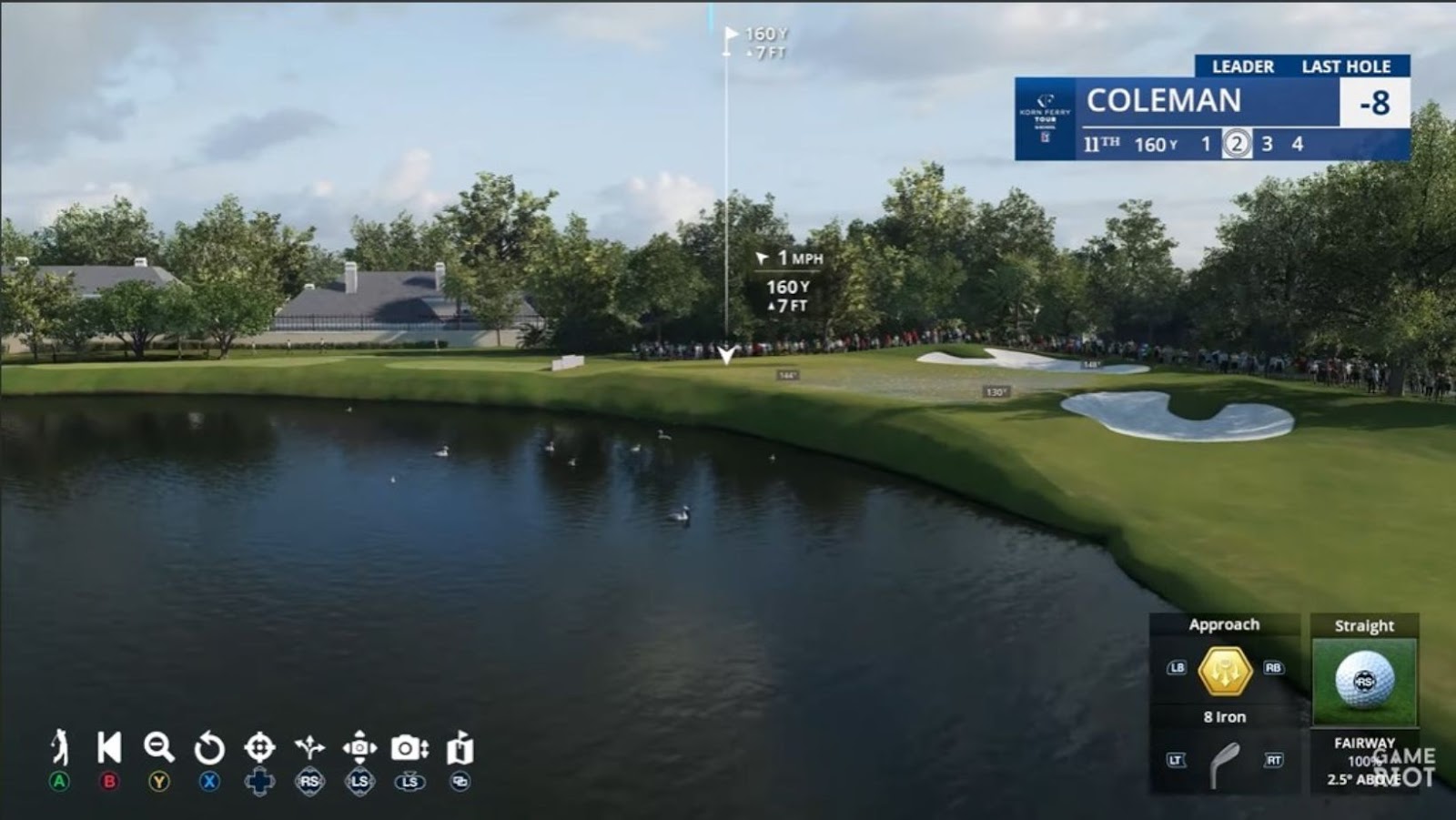EA Sports PGA Tour 16 Which Clubs Should I Use
When it comes to selecting the appropriate golf club for a course, there are some crucial factors to consider. Course layout, weather conditions and individual player preferences all play a part in club selection.
In order to understand golf club selection, we can refer to this table which provides information on the different types of golf clubs and their ideal use:
| Club Type | Ideal Use |
| Driver | For Tee Shots on Long Par-4s and Par-5s |
| Fairway Woods | For Shots from Fairways and Light Rough |
| Irons | Short Approach Shots and Chipping Around the Green |
| Wedges | For Close-Range Shots, High Trajectory Shots, Sand Bunkers |
| Putter | Used on The Green |
It is important to note that while this table provides a general guideline for club selection, personal preference should ultimately come into play as well. Additionally, players may have more success with hybrid clubs or specialty wedges in certain situations.
While many golfers may focus primarily on distance when selecting clubs, accuracy is equally important. A slight deviation in shot direction can greatly impact the success of a round.
A friend once shared with me their experience of trying out a new driver on a course they were unfamiliar with. Despite being able to hit the ball further with the new driver, they found themselves struggling to keep their shots in play due to inaccurate direction. It serves as a reminder that even if one has access to the latest equipment, it’s important that such selections are made based on sound judgement rather than solely chasing after distance gains.
Why bother with a caddy when you can just let EA Sports PGA Tour 16 tell you which club to use?
Choosing the right club for the right course
To choose the right club for the right course with “The Right Clubs for the Right Course” article, you need to use different clubs for different shots and understand the differences between them. These sub-sections will provide valuable solutions that can help you determine which clubs to use during your EA Sports PGA Tour 16 game and improve your chances of winning.
Using different clubs for different shots
To maximize your performance on the golf course, it’s crucial to choose the right club for each shot. Every club has different characteristics that make it ideal for specific shots. This guide will help you determine which club to choose for different situations.
Using Different Clubs for Different Shots:
| Club Type | Shot Type | Distance |
| Driver | Tee Shot | Long |
| Fairway Woods | Fairway Shots | Long/Medium |
| Hybrids | Fairway/Bunker/Occasional Tee Shots | Medium/Long |
| Irons | Fairway/Bunker/Rough/Shaping Shots | Short/Medium/Long |
| Wedges | Short Approach Shots/Tight Lies/Bunker Shots/Chipping/Pitching | Short |
When selecting a club, consider the length and height of your shot, as well as any obstacles such as trees or bunkers. For long tee shots, use a driver for maximum distance. For fairway shots that require more control, select fairway woods or hybrids depending on distance from the green. Irons come in handy for shaping your shot and getting out of bunkers or rough areas. Wedges are perfect when you’re near the green and need precision and finesse to finish the hole.
It’s important to note that every golfer is different and may benefit from using a certain type of club over another depending on their skill level and personal preferences.
A study conducted by Golf Digest found that choosing the right club can lead to significant improvements in a player’s game, with some players seeing results immediately after switching up their equipment.
Golf clubs are like relationships: you need to find the right fit and know when to switch it up.
Understanding the differences between clubs
When it comes to selecting the right club for the right course, one must understand the differences between each type of club. This knowledge can be crucial in achieving success on the golf course and can help golfers play more confidently and efficiently.
To better comprehend these differences, we have created a table detailing some of the key characteristics of every club. For example, drivers are typically used for long-distance shots from the tee box, whereas irons are used for shorter distance shots and providing more control over direction and trajectory. This information can help golfers make more informed decisions when selecting which club to use for any given shot.
It’s also important to note that while certain clubs may be better suited for specific types of shots or courses, each golfer may have individual preferences based on skill level and comfort with various clubs. Additionally, external factors such as wind speed and direction can influence which club is optimal for any particular shot.
A fascinating piece of history surrounding this topic involves the development of the sand wedge by Gene Sarazen in 1932. Before this invention, golfers would use irons to escape bunkers, often resulting in scuffed balls and frustration. Sarazen’s design revolutionized bunker play, allowing players to hit out of sand pits with more power and precision than ever before. This further illustrates how understanding club differences can greatly impact a player’s overall performance on the course.
Why settle for a bogey when you can have the stroke of a champion with EA Sports PGA Tour 16 club options?
EA Sports PGA Tour 16 club options
To analyze the club attributes and statistics, and experiment with different clubs in EA Sports PGA Tour 16, you need to have a deep understanding of the distinct challenges that each course presents. Taking into consideration the unique obstacles that each course poses, you can determine which club options are the most suitable.
Analyzing club attributes and statistics
Club Attributes and Statistics in EA Sports PGA Tour 16 are essential for gameplay. These attributes differentiate every club in the game, varying from distance, control, swing power, accuracy, and impact.
We present a comprehensive Table assessing various statistics of clubs in the game like Club Name, Distance, Fairways Hit %, GIR % (Green in Regulation), Scrambling %, Putts per Round. Analyzing these attributes assists a player to choose the right club that matches their playing style.
In addition to the above-discussed attributes and statistics of clubs in EA Sports PGA Tour 16, several other details require attention while selecting the appropriate club. Including weather conditions that affect ball flight and wind speed affecting ball direction. Taking these factors into account will allow you to make an informed decision when selecting a club that suits your playstyle.
Pro Tip: Practice with different clubs before indulging in tournaments or challenges to understand your strengths and weaknesses with those particular clubs. It improves chances of being successful on the course.
Why settle for just one club when you can experiment with a whole bag of frustrations in EA Sports PGA Tour 16?
Experimenting with different clubs in the game
Playing with different golf clubs: how to make the most of EA Sports PGA Tour 16.
Create an informative table using tags. For the purpose of experimenting with different clubs in the game, here is a list of different club options that can enhance your gameplay:
| , |
| Type of Club | Benefit |
| Driver | Increases distance for tee shots |
| Irons | Improve accuracy on approach shots |
| Wedges | Ideal for short-range shots and getting out of tough lies |
| Putters | Helps you sink those crucial putts |
As you play the game, it’s important to see which golf club category suits your playing style. EA Sports PGA Tour 16 has a wide range of golf club options that can help you create new strategies and techniques depending on your preferred shot style.
Utilizing the right golf club could mean the difference between winning or losing in-game competitions. Experimenting with gaming options and improving your gameplay strategy can be an exciting challenge. So why not take it on?
Don’t miss out on discovering various possibilities in EA Sports PGA Tour 16 by trying out distinctive ways to use golf clubs in your game plan. Start testing out these club options today!
Why settle for a bogey when you can have a birdie? Choose your clubs wisely and leave your opponents asking ‘Why didn’t I think of that?’
Tips for improving club selection in real life
To improve your club selection in real-life golfing, you need to gauge the course conditions and layout, practice and experiment with different clubs, and seek advice from professionals or experienced players. By considering these sub-sections, you can determine the best clubs for the course and enhance your overall golfing experience.
Considering course conditions and layout
Golfers must take into consideration the topography, course conditions, and layout when selecting a club. The natural features of the golf course can have a considerable impact on the shot’s outcome.
A golfer must observe the wind speed and direction, temperature, and humidity when choosing their club. Additionally, players need to evaluate the type of terrain they are playing on. This includes considering the slope, grass height and texture, sand quantities in bunkers or hazards.
Moreover, calculating golf shots’ distances from tee to green through landmarks is important for club selection. Players may also use distance-measuring tools like GPS devices or range finders for precise readings.
When taking all of these factors into account while selecting clubs, golfers can reduce their scores. It is vital to continuously observe potential issues and make adjustments accordingly. As every shot played is different from its previous one or next one due to changing conditions on-course.
To become a better golfer who makes informed decisions by taking note of all details that impact their game, a habit of understanding each course before playing needs to be adopted. Don’t miss out on refining your skills with attentive observations in contrast with rushing through precious seconds it takes for a perfect shot selection.
Remember, trial and error is the only way to figure out which club is best for hitting your ex’s car without leaving a dent.
Practice and experimentation
Enhancing one’s game requires consistent repetition and trial-and-error. The act of attempting different clubs in varying conditions and noting the resulting ball trajectories enables players to select the most appropriate club for each shot. This hands-on approach trains muscle memory and builds players’ overall understanding of their equipment’s functionality.
Experimenting with various distances, aiming points, and weather conditions can expand players’ skill set. Practising hitting shots with a club from different angles or switching hands can help determine one’s optimal shot style.
Exploring new courses provides an opportunity to test clubs specific to unfamiliar terrain, frequent obstacles or unusual bunkers. Consistently experimenting with a diverse range of clubs increases the chance of success on course day.
One example of a skilled player attaining mastery through further testing is Jack Nicklaus. After playing professionally for multiple years, his distant shots started taking too much height and became unreliable as they landed farther away from the hole. He then analysed how his shaft was designed and discovered that it could be shortened. As he slowly started using shorter shafts, his game improved drastically.
If asking a pro for club selection advice doesn’t work, just close your eyes and pick one at random. It’s worked for me in the past.
Seeking advice from professionals or experienced players
One way to improve your club selection in real life is by tapping into the knowledge of seasoned players or professionals. Seek out tips and advice from those who have spent years honing their skills on the course. This can be done through private lessons, online forums, or even by playing alongside skilled players. The insights you gain can help you better understand the nuances of the game and make more informed decisions when it comes to selecting your clubs.
In addition to seeking guidance from experienced golfers, it’s also important to do your own research on different types of clubs and their specific uses. Take time to read up on equipment reviews, test out different clubs at a shop or driving range, and consider factors such as shaft length, loft angle, and durability before making a final purchase. By becoming an informed consumer, you’ll be better equipped to select clubs that are tailored to your individual play style.
Finally, always keep in mind that club selection isn’t just about finding the right tools for a given shot – it’s also about having confidence in yourself and your abilities. Don’t be afraid to experiment with different clubs and swing techniques until you find what works best for you. With practice and determination, you’ll be able to master even the most challenging holes on the course.
Pro Tip: When trying out new clubs or making adjustments to your swing technique, start slowly and focus on achieving consistency rather than power. Over time, you can work on gradually increasing your distance without sacrificing accuracy or control.



